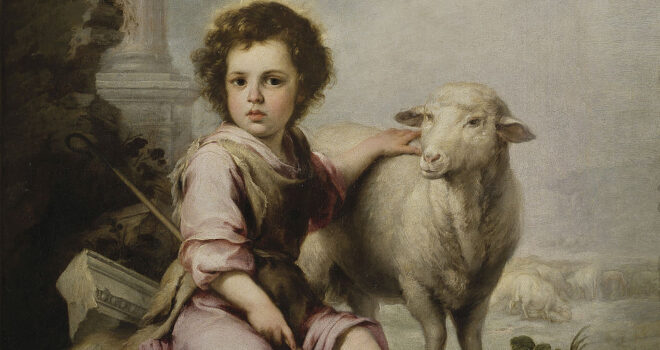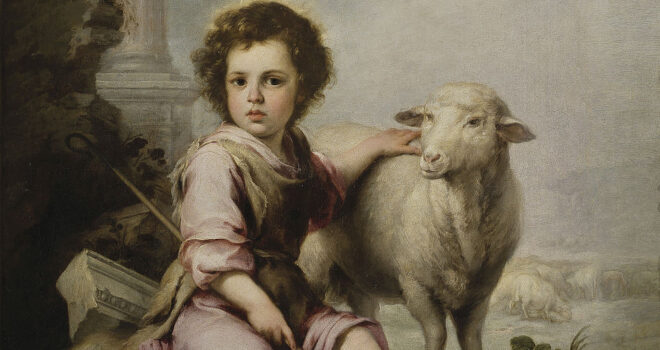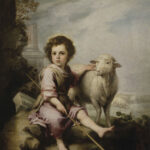Viewing and pondering sacred art, engaging in vizio divina, offers the faithful a great way to meditate more deeply on the life of Jesus Christ and the mystery of salvation. This series of articles will highlight several pieces of art related to the glorious Easter season, with specific attention to Scripture readings. Each of these pieces of art allows us to reflect on the astonishing realities of the resurrected life.
On the Fourth Sunday of Easter in each liturgical cycle, the Church presents to the faithful a portion of Jesus’ Good Shepherd Discourse, recorded in the tenth chapter of St. John’s Gospel. It is one of the most beloved passages in all of Sacred Scripture, and it is especially prevalent in learning and spirituality for children. It reminds the faithful of how Jesus is both gatherer and defender of those who hear His voice and follow.
Bartolomé Esteban Murillo, one of the great artists of the Baroque era in Europe, produced several memorable depictions of Jesus, the Good Shepherd. The depiction that he made around 1660, which hangs today in the Prado Museum in Madrid, is perhaps the most famous and memorable. This version contains some important details that depict Jesus as Gatherer and Defender, the quintessential tasks of a shepherd.

As a viewer approaches this painting, the very first thing he notices is that Jesus is depicted as a child. It is no coincidence that Murillo decided to use the child, since there are multiple moments throughout the Gospel narratives when Jesus (see Mt. 18:3-4 and Lk. 9:46-48). More than that, in this passage, Jesus tells His audience, “I came so that they might have life and have it more abundantly” (Jn. 10:10). Who has life more abundantly than a joyful child? Have I let myself become more childlike to experience the joy that Jesus wants me to have?
This Child’s gaze pierces into the viewer’s soul. This gaze might cause the viewer to think about his or her own connection with the Good Shepherd. With His eyes, He says, “I want a deeper relationship with you. I want to gather you to myself and protect you.” Being drawn in by His gaze will allow us to “recognize his voice” more clearly (Jn. 10:4). Am I willing to meet the Good Shepherd’s gaze and hear His voice
The Christ Child holds a staff under his right arm, the quintessential tool of a shepherd. It is a tool for both gathering, by the crook, and defending. What are the tools that Jesus uses to gather people into relationship with Him through His Church? What are ways that He defends His flock? What has he done to gather and defend me, personally?
The Shepherd’s left hand rests on a sheep. The look on His face conveys a stark seriousness. By His look, and by the placement of His hand, the Good Shepherd says, “My Father, who has given them to me, is greater than all, and no one can take them out of the Father’s hand. The Father and I are one” (Jn. 10:29-30). As I gaze on this painting, can I recall times when I have felt the protective hand of the Lord in my life? Have I ever though of myself as a feeble, even helpless sheep? Has the Lord been tender to me in the midst of such feebleness?
Behind the Shepherd and His one sheep, on the right-hand side of the painting, is a herd of sheep. This causes the viewer, first, to think about Jesus teaching in the Good Shepherd discourse: “I have other sheep that do not belong to this fold. These also I must lead, and they will hear my voice, and there will be one flock, one shepherd” (Jn. 10:16). Do I realize that God wants every person as a part of His sheepfold? Even as a sheep, am I willing and ready to help other sheep come into the one flock of the Lord, the Church? How can I do that in my own life?
It also seems that Murillo has used the distant flock as a visual statement of Jesus’ well-known parable of the lost sheep (see Mt. 18:10-14 and Lk. 15:1-7); of the ninety-nine who remained faithful. The sheep that is right next to the Good Shepherd, caressed by His hand, also represents the “one sinner who repents,” who is the cause of more rejoicing than “ninety-nine righteous persons” (Lk. 15:7 ESV). Am I willing to view myself as a lost sheep? Am I willing and ready to allow the Lord to change my sinful ways and lead me back to the flock?
Finally, there is one of the most significant details of the painting. Just behind the Shepherd Child is part of a destroyed building, while further back there is a broken and toppled column. It seems that Murillo uses these images to convey that Jesus and His teaching have conquered ancient paganism, especially instantiated in the Roman Empire: “All who came before me are thieves and robbers; but the sheep do not listen to them. … A thief comes only to steal and slaughter and destroy…” (Jn. 10:8-10). The serenity of the Good Shepherd who gathers, defends, and bestows abundant life stands in stark contrast to the wreckage and ruins. Have there been areas of my life that the Lord had to topple and overcome? Have I been drawn into the fullness of truth, slowly discarding my old ways of seeking wealth, pleasure, power, or honor and seeking the Lord instead?
While Murillo’s painting offers relatively few details, the ones that he does offer are quite poignant. Through them all, the viewer can come to know Jesus more deeply as gatherer and defender, the one who protects the whole flock while searching out the lost sheep who are astray. The viewer can then reflect on his or her own relationship to the Good Shepherd, and to the One True Flock, the Church. Growing in this awareness will allow each of us to appreciate more fully the depth of the Paschal Mystery and the Easter season.
The Good Shepherd by Bartolomé Esteban Murillo is in the public domain.













